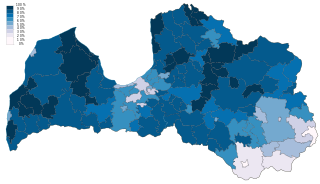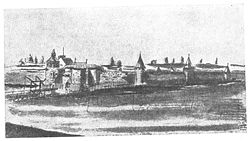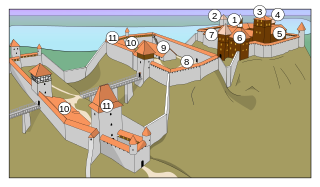The Livonian Brothers of the Sword was a Catholic military order established by Albert, the third bishop of Riga, in 1202. Pope Innocent III sanctioned the establishment in 1204 for the second time. The membership of the order comprised German "warrior monks" who fought Baltic and Finnic pagans in the area of modern-day Estonia, Latvia and Lithuania. Alternative names of the Order include Christ Knights, Sword Brethren, and The Militia of Christ of Livonia. The seal reads: +MAGISTRI ETFRM MILICIE CRI (Christi) DE LIVONIA.

Cēsis, is a town in Latvia located in the northern part of the Central Vidzeme Upland. Cēsis is on the Gauja River valley, and is built on a series of ridges above the river overlooking the woods below. Cēsis was one of the candidate cities for the title of European Capital of Culture 2014.

Ordensburgs were fortresses built by crusading German military orders during the Middle Ages. The term "Ordensburgen" was also used during Nazi Germany to refer to training schools for Nazi leaders.
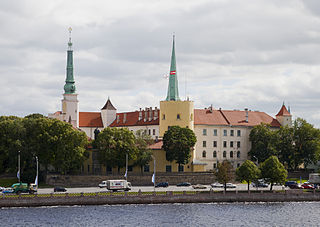
Riga Castle is a castle on the banks of River Daugava in Riga, the capital of Latvia. The castle was founded in 1330. Its structure was thoroughly rebuilt between 1497 and 1515. Upon the castle's seizure by the Swedes, they constructed spacious annexes in 1641. The fortress was continually augmented and reconstructed between the 17th and 19th centuries. Sometime in the 1930s, some renovation work was done by architect Eižens Laube. The Latvian government declared the castle its residence in 1938. Today it is the official residence of the President of Latvia as well as home to several museums.
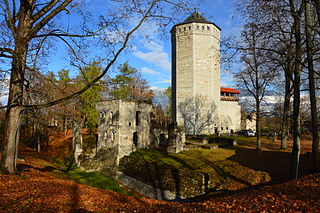
Paide is the capital of Järva County, Estonia.

The Castle of the Teutonic Order in Malbork is a 13th-century Teutonic castle and fortress located near the town of Malbork, Poland. It is the largest castle in the world measured by land area and a UNESCO World Heritage Site.
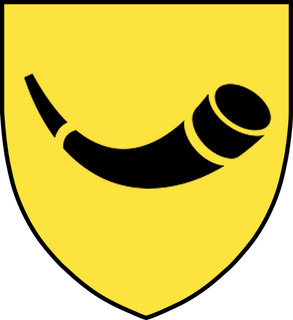
Horn is a Swedish noble family from Finland, known since the 14th century.
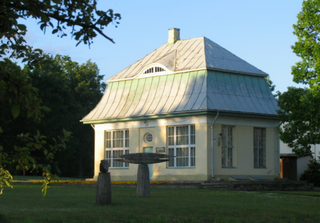
Johann Ernst Glück was a German translator and Lutheran theologian active in Livonia, which is now in Latvia.
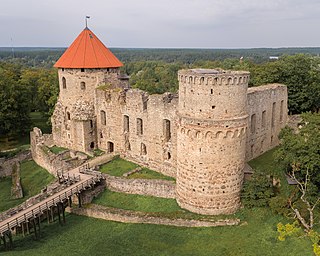
Cēsis Castle is one of the most iconic and best preserved medieval castles in Latvia. The foundations of the castle were laid 800 years ago by the Livonian Brothers of the Sword. The most prosperous period Cēsis Castle experienced was during its next owners, the Teutonic Order. It became one of the key administrative and economic centers of the Teutonic Order in Livonia. The first serious damage was done to the castle during the Livonian War, when it was besieged by the army of Ivan the Terrible. In the course of the siege of 1577 approximately 300 people within the castle committed mass suicide by blowing themselves up with gunpowder. Cēsis Castle was still in use during the following century but it fell into disuse after the Great Northern War. Today the castle is the most visited heritage site in Cēsis and one of the 'must see' destinations in the Baltic states.
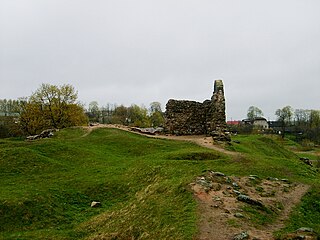
Rēzekne Castle ruins are located in the centre of Rēzekne, Latvia, a city in the centre of Latgale. The castle served as a base of the local Livonian order landlords until the 16th century and also as the main military support base for battles against Russians and Lithuanians. Today, fragments of the stone walls and the foundation can be seen on the ancient castle hill.

The Krimulda Castle is located just outside Sigulda, Sigulda municipality, Latvia and is a tourist attraction. The castle dates from the 14th century and was destroyed in a war in 1601. Prince Liven’s living house was built in the classic style. The manor complex consists of steward’s house, coach house, Swiss cottage, etc. Home wine tasting is available by prior arrangement.

Ventspils Castle is located in Ventspils, Latvia. It is one of the oldest and most well-preserved Livonian Order castles remaining, in that it has retained its original layout since the 13th century. Through its 700-year history, it has been used as a fortress, residence, garrison, school, military base, and prison. In 1995, the castle was restored to its 19th-century appearance, and was converted into a museum.

Ēdole Castle is a Gothic Revival castle situated on the banks of Ēdole Lake, Ēdole parish, in the historical region of Courland, western Latvia. Originally consisting of two residential buildings linked by a stone wall, the castle is surrounded by landscape park. It is considered an architectural and archaeological monument of national importance.
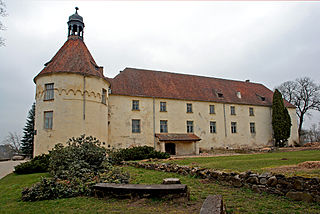
Jaunpils Castle is a castle in the historical region of Zemgale, in Latvia. More of a manor house than properly a fortified castle, it has now been converted into a hotel.

Dzērbene Manor is a manor house in the historical region of Vidzeme, northern Latvia. Modern manor house is built on the place where old Dzērbene medieval castle once stood. Dzērbene manor is mentioned for the first time in 1555 when it was presented to chancellor of Archbishopric of Riga Christoph Sturz. In 1556 old castle was destroyed by army of Livonian Order and in 1577 also by Muscovites. During period of Swedish Livonia Dzērbene manor was owned by Svante Banner. After Great Northern War Dzērbene manor complex with more than 20 buildings became property of Russian Empire. In 1771 Russian empress Catharina II presented property to the major-general Otto Weismann von Weissenstein. His descendants owned the manor until 1891. From 1891 property was owned by von Laudohn family. Manor house was burned during Russian revolution of 1905 but was rebuilt later. During First world war manor saw further damage and last owners departed for Germany.

Ludza Castle was a medieval castle built in Gothic style located next to a Catholic church, on the site of a former Latgalian wooden castle in the centre Ludza, Latvia, a small town in eastern Latgale. Its main purpose was to be an eastern outpost to control trade routes from Russia. Nowadays the impressive fragments of the castle walls, including a three-floor high fragment, still remain. The ruins are the main tourist attraction in the Ludza District, and is considered a symbol of the town.
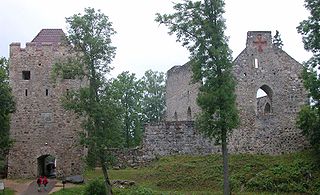
Sigulda Medieval Castle ruins are located on the edge of the Gauja valley in Latvia. The original castle was built in 1207 as a castellum type fortress, later rebuilt into a convent type building. The residence of the Land Marshal of the Livonian Order since 1432.
Ernst Gottlieb Glück was a Russian statesman.
